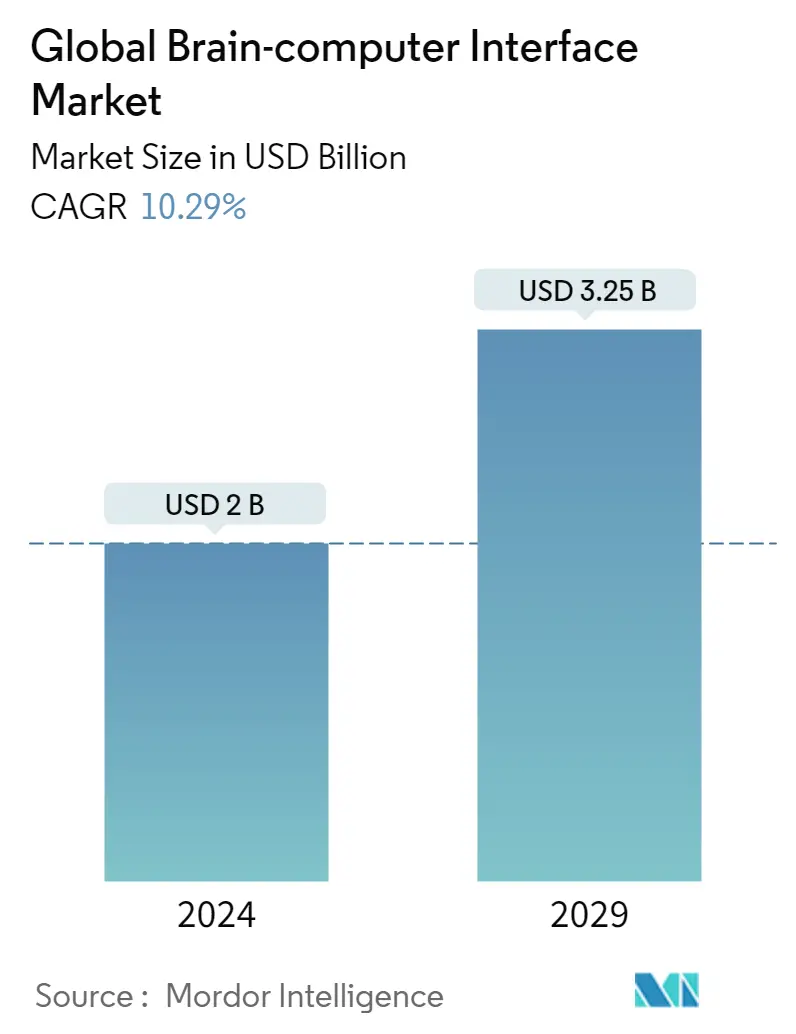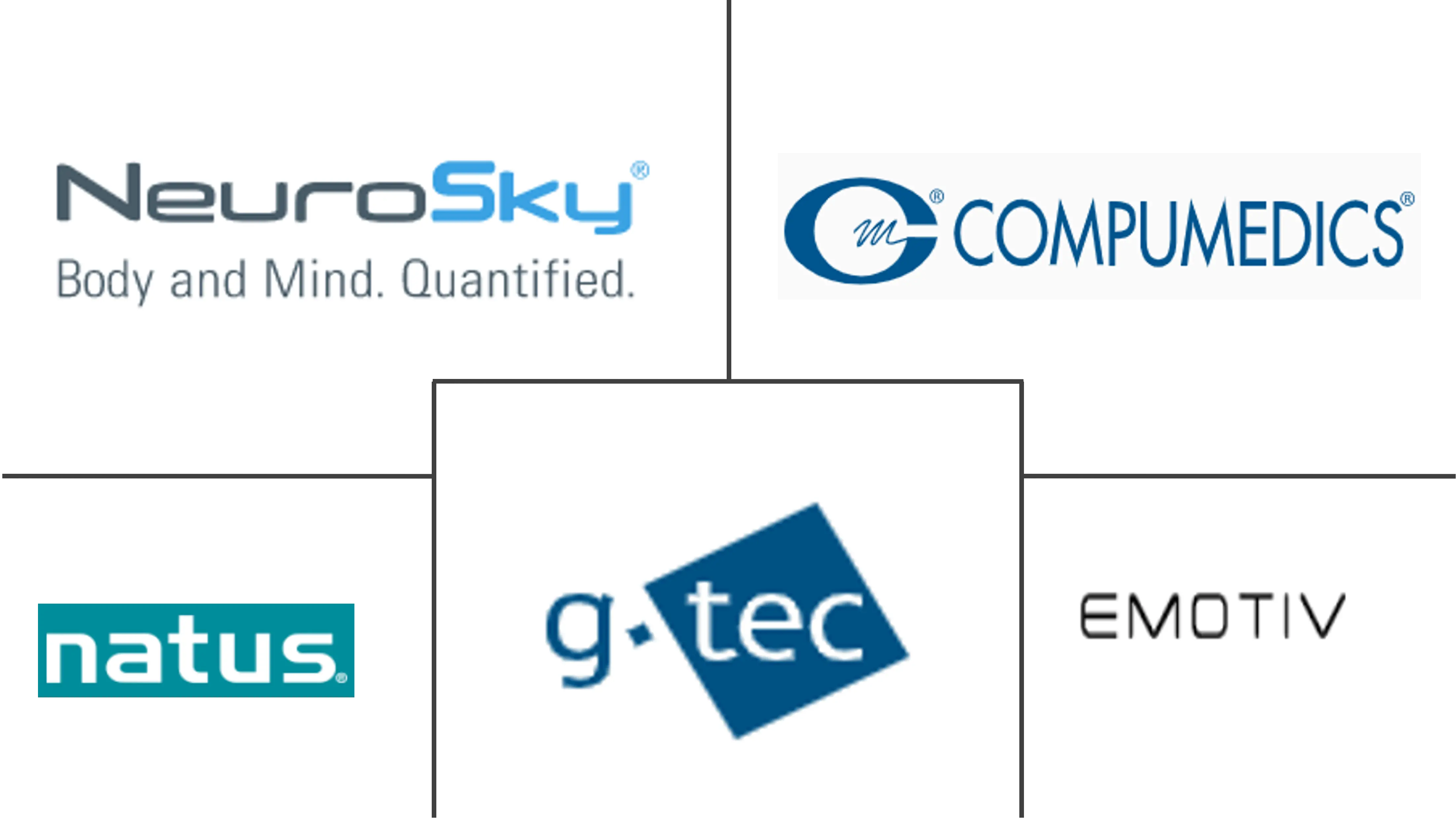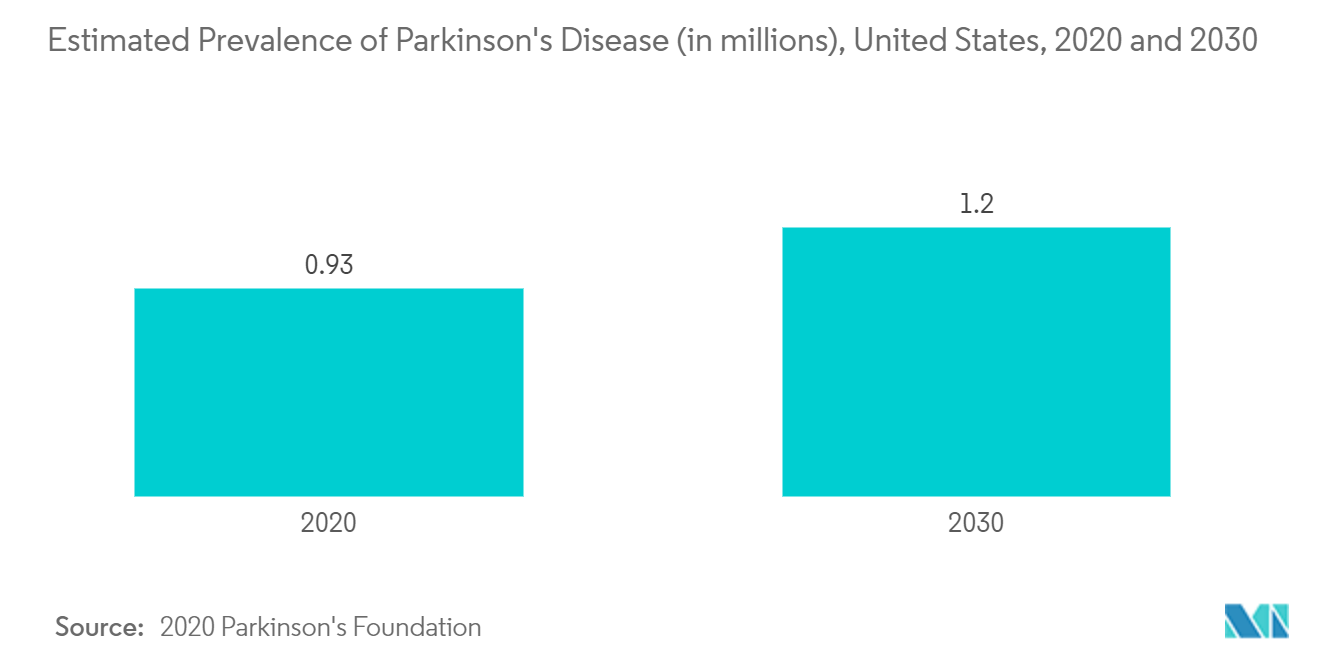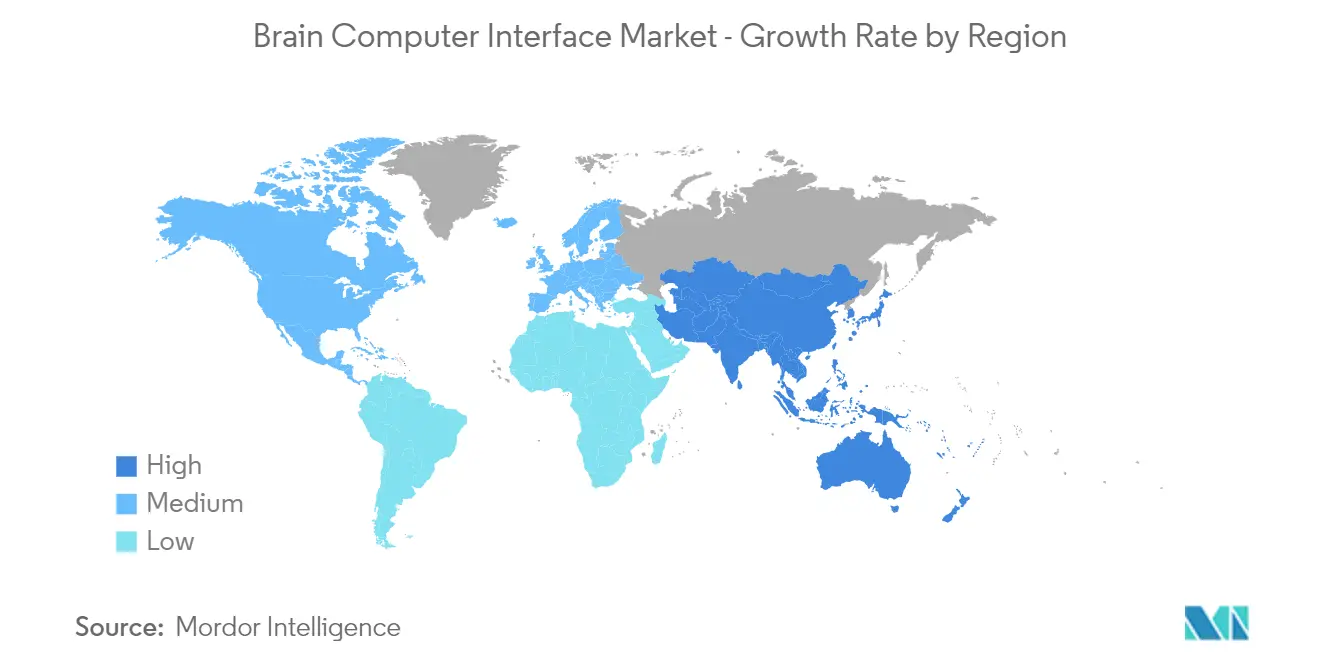Brain-Computer Interface Market Size

| Study Period | 2019 - 2029 |
| Market Size (2024) | USD 2.00 Billion |
| Market Size (2029) | USD 3.25 Billion |
| CAGR (2024 - 2029) | 10.29 % |
| Fastest Growing Market | Asia Pacific |
| Largest Market | North America |
Major Players
*Disclaimer: Major Players sorted in no particular order |
Brain-Computer Interface Market Analysis
The Global Brain-computer Interface Market size is estimated at USD 2 billion in 2024, and is expected to reach USD 3.25 billion by 2029, growing at a CAGR of 10.29% during the forecast period (2024-2029).
The initial impact of COVID-19 on the market was significant owing to lockdowns and disruptions in manufacturing and supply chain activities. However, the COVID-19 pandemic has hastened the deployment of new technologies while also increasing end users' reliance on them. The rising usage of brain-computer interface (BCI) technology for the treatment of many elderly patients suffering from physical impairments to translate specific signal features that reflect the elderly's intent into commands and enable them to improve their motor and cognitive abilities, which can be used as a promising tool in rehabilitation medicine during COVID-19, is likely to have a positive impact on the market growth. According to the report "Motor-Imagery EEG-Based BCIs in Wheelchair Movement and Control: A Systematic Literature Review" published in September 2021, the COVID-19 has created an opportunity for the development and implementation of innovative devices like BCIs, biomedical solutions, and assistive technologies (AT) to facilitate people with severe disabilities regarding their participation in daily life.
Further, the brain-computer interface market is likely to show rapid growth due to the increasing prevalence of neurodegenerative disorders, rising R&D activities by the companies to improve the brain-computer interface technology and various technological advancements such as miniaturization of devices.
Among all the factors, the increasing prevalence of neurodegenerative disorders is the foremost factor expected to drive the brain-computer interface market over the forecast period. According to the Parkinson's Foundation, more than 930,000 people in the United States were likely to be suffering from Parkinson's disease in 2020. Moreover, the report by the foundation also predicted that the number of people with Parkinson's disease is expected to rise to 1.2 million by 2030. This represents a projected increase of about 1.8 times in Parkinson's prevalence since 2010, highlighting the need for optimized care and treatment strategies for this patient population to diminish the burden of care on caregivers and ease the economic burden on the healthcare system. Therefore, most of these patients eventually require continuous care and monitoring or help, which can be facilitated by the use of brain-computer interface devices.
Moreover, the increase in R&D activities by various companies and investments from the governments in brain-computer interface technology development and new applications is a chief factor that may promote the growth of the market during the forecast period. For instance, according to an article titled "Funding for Brain-Computer Interface Ventures" published in August 2020, the Australian Federal Government awarded a USD 42 million grant to a research consortium called Bionic Vision Australia to develop bionic vision technology, a type of brain-computer interface technology. The technology was later transferred to Bionic Vision Technologies, which raised USD 18 million from private funders, presumably for further clinical trials and further development. Such investments by governments supporting technological innovation are increasing across the world, which will drive the market's growth globally.
However, the high cost of brain-computer interface devices and a lack of expertise in implementing the systems are the major factors hindering the market's growth.
Brain-Computer Interface Market Trends
This section covers the major market trends shaping the Brain-computer Interface Market according to our research experts:
The Non-invasive Brain-computer Interface Segment is Expected to Dominate the Market During the Forecast Period
By type, the non-invasive brain-computer interface segment is expected to witness significant growth. The non-invasive brain-computer interface segment is found to dominate the overall market owing to the high applicability of the technology and increasing neurological disorders. The development of non-invasive brain-computer interface devices based on EEG is expected to increase the mainstream accessibility of BCI technology. Moreover, growth in the number of approvals is also expected to supplement the market's growth. For instance, in April 2021, the United States Food and Drug Administration (FDA) approved the use of a brain-computer interface device to aid stroke patients with hand, wrist, and arm disabilities in their recovery. The IpsiHand Upper Extremity Rehabilitation System (IpsiHand System) was developed by Neurolutions and records brain activity using non-invasive electroencephalography (EEG) electrodes (rather than the more typical electrodes implanted into the brain).
Also, the increasing research and development activities and product launches pertaining to the non-invasive brain-computer interface segment are contributing to the market's growth. For instance, in January 2020, NextMind, a Paris-based brain-computer interface (BCI) startup, launched a neural interface dev kit at CES for USD 400. This device is a non-invasive electroencephalogram (EEG), which is a well-established method of measuring the voltage fluctuations of neurons from outside the skull.
Thus, due to the above-mentioned factors, the segment is expected to witness significant growth during the forecast period.

Asia-Pacific is Found to be the Fastest Growing Segment of the Market
The Asia-Pacific brain-computer interface market is anticipated to grow significantly over the forecast period, particularly in developing countries such as Japan and China. The market is characterized by technological advancements that are expected to result in the availability of better options for healthcare personnel and individuals.
Furthermore, in 2020, Chinese researchers developed a neural signal analysis system with memristor arrays, paving the way for high-efficiency brain-machine interfaces, and used the system to implement the filtering and identification of epilepsy-related neural signals, achieving an accuracy of over 93%. The system draws upon work from researchers in the fields of electronics and medical research. Such developments are anticipated to have a positive impact on the growth of the market in the Asia-Pacific region.
Additionally, new technology encompasses a wide array of applications designed to revolutionize security, automation, and communication experiences. For instance, in 2021, a neuro-engineering team at Tianjin University was working on the research and development of the second-generation "BrainTalker" chip, which uses less power and offers higher system-on-chip integration, and the researchers reported that they were able to capture "good-quality" brain intentions from electroencephalogram signals that could satisfy application demands.
Thus, due to the above-mentioned factors, the market is expected to witness significant growth over the forecast period.

Brain-Computer Interface Industry Overview
The brain-computer interface market is moderately competitive and has the presence of well-diversified international, regional, and local players. However, some big international players, such as Natus Medical Incorporated, Compumedics Ltd, Emotive Incorporation, g.tec medical engineering GmbH, and NeuroSky, dominate the market owing to their brand image and market reach. The companies are found investing in new technologies to provide a digital change to their customers.
Brain-Computer Interface Market Leaders
-
Natus Medical Incorporated
-
Compumedics Ltd
-
EMOTIV
-
g.tec medical engineering GmbH
-
NeuroSky
*Disclaimer: Major Players sorted in no particular order

Brain-Computer Interface Market News
In November 2021, NeuraMatrix, a brain-computer interface platform company, completed a CNY 100 million round of financing. The first system-on-chip was anticipated to be mass-produced by the end of the year.
In October 2021, EMOTIV introduced the New EMOTIV Launcher and enhancements to EmotivPRO Suite 3.0. The product is a full end-to-end solution to streamline neuroscience research completely.
Brain-Computer Interface Market Report - Table of Contents
1. INTRODUCTION
- 1.1 Study Assumptions and Market Definition
- 1.2 Scope of the Study
2. RESEARCH METHODOLOGY
3. EXECUTIVE SUMMARY
4. MARKET DYNAMICS
- 4.1 Market Overview
-
4.2 Market Drivers
- 4.2.1 Increasing Prevalence of Neurodegenerative Disorders
- 4.2.2 Rising R&D Activities by Government to Improve the Brain-computer Interface Technology
- 4.2.3 Various Technological Advancements such as Miniaturization of Devices
-
4.3 Market Restraints
- 4.3.1 High Cost of Brain-computer Interface Devices
- 4.3.2 Lack of Expertise in Implementing the Systems
-
4.4 Porter's Five Forces Analysis
- 4.4.1 Threat of New Entrants
- 4.4.2 Bargaining Power of Buyers/Consumers
- 4.4.3 Bargaining Power of Suppliers
- 4.4.4 Threat of Substitute Products
- 4.4.5 Intensity of Competitive Rivalry
5. MARKET SEGMENTATION (Market Size by Value - USD million)
-
5.1 By Type
- 5.1.1 Invasive Brain-computer Interface
- 5.1.2 Non-invasive Brain-computer Interface
- 5.1.3 Other Types
-
5.2 By Application
- 5.2.1 Restoration of Disabilities
- 5.2.2 Repair of Brain Function
- 5.2.3 Other Applications
-
5.3 By Geography
- 5.3.1 North America
- 5.3.1.1 United States
- 5.3.1.2 Canada
- 5.3.1.3 Mexico
- 5.3.2 Europe
- 5.3.2.1 Germany
- 5.3.2.2 United Kingdom
- 5.3.2.3 France
- 5.3.2.4 Italy
- 5.3.2.5 Spain
- 5.3.2.6 Rest of Europe
- 5.3.3 Asia-Pacific
- 5.3.3.1 China
- 5.3.3.2 Japan
- 5.3.3.3 India
- 5.3.3.4 Australia
- 5.3.3.5 South Korea
- 5.3.3.6 Rest of Asia-Pacific
- 5.3.4 Middle-East and Africa
- 5.3.4.1 GCC
- 5.3.4.2 South Africa
- 5.3.4.3 Rest of Middle-East and Africa
- 5.3.5 South America
- 5.3.5.1 Brazil
- 5.3.5.2 Argentina
- 5.3.5.3 Rest of South America
6. COMPETITIVE LANDSCAPE
-
6.1 Company Profiles
- 6.1.1 Natus Medical Inc.
- 6.1.2 g.tec medical engineering GmbH
- 6.1.3 Medtronic PLC
- 6.1.4 Compumedics Ltd
- 6.1.5 Nihon Kohden Corporation
- 6.1.6 Integra LifeSciences Corporation
- 6.1.7 Advanced Brain Monitoring Inc.
- 6.1.8 Emotive Incorporation
- 6.1.9 NeuroSky
- 6.1.10 ANT Neuro
- 6.1.11 NextMind
- 6.1.12 Cadwell Industries Inc.
- 6.1.13 MindMaze
- 6.1.14 Brain Products GmbH
- 6.1.15 NIRx Medical Technologies
- *List Not Exhaustive
7. MARKET OPPORTUNITIES AND FUTURE TRENDS
** Subject To AvailablityBrain-Computer Interface Industry Segmentation
As per the scope of the report, a brain-computer interface is a system that facilitates a direct communication pathway between a functional brain and peripheral electronic devices that are used to calibrate the movement in physically challenged individuals. A brain-computer interface system records the brain signal from the surface of the cortex through signaling devices implanted within the brain or from the sensors placed over the scalp. These signals are then transmitted to the connected peripheral device that enables the operator to perform numerous tasks. The brain-computer interface market is segmented by type (invasive brain-computer interface, non-invasive brain-computer interface, and other types), application (restoration of disabilities, repair of brain function, and other applications), and geography (North America, Europe, Asia-Pacific, Middle-East and Africa, and South America). The market report also covers the estimated market sizes and trends for 17 different countries across major regions globally. The report offers the value (in USD million) for the above segments.
| By Type | Invasive Brain-computer Interface | |
| Non-invasive Brain-computer Interface | ||
| Other Types | ||
| By Application | Restoration of Disabilities | |
| Repair of Brain Function | ||
| Other Applications | ||
| By Geography | North America | United States |
| Canada | ||
| Mexico | ||
| By Geography | Europe | Germany |
| United Kingdom | ||
| France | ||
| Italy | ||
| Spain | ||
| Rest of Europe | ||
| By Geography | Asia-Pacific | China |
| Japan | ||
| India | ||
| Australia | ||
| South Korea | ||
| Rest of Asia-Pacific | ||
| By Geography | Middle-East and Africa | GCC |
| South Africa | ||
| Rest of Middle-East and Africa | ||
| By Geography | South America | Brazil |
| Argentina | ||
| Rest of South America |
Brain-Computer Interface Market Research FAQs
How big is the Global Brain-computer Interface Market?
The Global Brain-computer Interface Market size is expected to reach USD 2.00 billion in 2024 and grow at a CAGR of 10.29% to reach USD 3.25 billion by 2029.
What is the current Global Brain-computer Interface Market size?
In 2024, the Global Brain-computer Interface Market size is expected to reach USD 2.00 billion.
Who are the key players in Global Brain-computer Interface Market?
Natus Medical Incorporated, Compumedics Ltd, EMOTIV, g.tec medical engineering GmbH and NeuroSky are the major companies operating in the Global Brain-computer Interface Market.
Which is the fastest growing region in Global Brain-computer Interface Market?
Asia Pacific is estimated to grow at the highest CAGR over the forecast period (2024-2029).
Which region has the biggest share in Global Brain-computer Interface Market?
In 2024, the North America accounts for the largest market share in Global Brain-computer Interface Market.
What years does this Global Brain-computer Interface Market cover, and what was the market size in 2023?
In 2023, the Global Brain-computer Interface Market size was estimated at USD 1.81 billion. The report covers the Global Brain-computer Interface Market historical market size for years: 2019, 2020, 2021, 2022 and 2023. The report also forecasts the Global Brain-computer Interface Market size for years: 2024, 2025, 2026, 2027, 2028 and 2029.
What are the key factors driving the Brain Computer Interface (BCI) Market?
The key factors driving the Brain Computer Interface (BCI) Market are a) Integration of Brain Computer Interface (BCIs) in gaming platforms for immersive experiences can create new market opportunities b) Development of less invasive BCIs using wearables or non-surgical methods could broaden market reach
Brain-Computer Interface Industry Report
The brain computer interface (BCI) market is on a significant upward trend, due to the growing demand to mitigate neuroprosthetic conditions, an aging global population, and rapid technological evolution. Its utility spans virtual gaming, home automation, and military communications, catering especially to the needs arising from neurodegenerative diseases such as Alzheimer's and Parkinson's. The non-invasive BCI segment, known for its safety and wide applicability in creating devices like mind-controlled robotic arms, is leading the market. However, invasive and partially invasive technologies are also gaining ground due to their potential in enhancing the lives of paralytic individuals. The healthcare sector benefits immensely from BCI for managing neurological conditions and sleep disorders, while smart home integrations are improving lifestyle convenience. With robust investments in research and strategic industry collaborations, the BCI market is poised for groundbreaking developments, reshaping how the human brain interacts with technology. Get a sample of this industry analysis as a free report PDF download.



